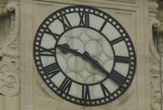Extra Second Will be Added to 2005

Editor's Note: This story was originally published in July and is being highlighted now because the event is near.
An extra second will be added to 2005 to make up for the slowing down of the Earth's rotation. Scientists announced the addition July 5.
The once-common "leap second" is the first in seven years and reflects the unpredictable nature of the planet's behavior.
The International Earth Rotation and Reference Systems Service in Paris keeps track of time by measuring the Earth's rotation, which varies, and by an atomic clock, which is unwavering. When a difference in the two clocks shows up, the IERS adds or subtracts a second to the year.
For the first time since 1998, the IERS will sneak in an extra second this year to get time back in synch, officials said in a statement Monday.
On Dec. 31, the clock will read like this as it leads into Jan. 1, 2006:
23h 59m 59s ... 23h 59m 60s ... 00h 00m 00s. Normally, the seconds would roll from 59 directly to 00.
Get the world’s most fascinating discoveries delivered straight to your inbox.
Always on time
"As the Earth is slowing down compared to atomic clock time, noon is going to come a little later. Earth rotation time is falling behind atomic clock time," said Tom O'Brian, Chief of the Time and Frequency Division at the U.S. National Institution of Standards and Technology. "Periodically people have to add time to atomic clock time. When those two times are approaching about a second difference, we add a leap second."
While time has been measured by the planet's rotation for thousands of years, it wasn't until 1949 that scientists developed a clock that kept perfect time.
"An atomic clock keeps time by looking at the fundamental vibrations of atoms," O'Brian said. "It's like middle "C" on a tuning fork – a particular kind of atom has a set of frequencies that can be used to keep time."
The current standard is a cesium atom, which vibrates 9,192,631,770 times per second. As far as scientists know, this doesn't change over time and is the same everywhere on Earth and in space.
Tiny changes
The first leap second was added in 1972, as technology allowed for more accurate timekeeping, and they were all the rage in the beginning. At least one was added every year between 1972 and 1983 before a slight drop-off in the mid-eighties and nineties.
"And then, in 1999 for reasons still unknown, the rotation of the Earth speeded up a bit, so we haven't had to add a second since then," O'Brian told LiveScience in a telephone interview.
Part of the secret behind Earth's changing speeds is tidal force exerted by the Moon, which is responsible for the gradual slowing of our planet's rotation over time. But other slight forces are at work, such as changes in the season, movement of rock in the molten core, and other factors that scientists have yet to uncover.
Seasons, particularly those in the Northern Hemisphere, change the planet's rotational speed predictably during the year. Water evaporates from the sea surface and comes down as rain and snow in the mountains and eventually melts back to the sea.
This creates an effect similar to an ice skater sticking her arms out to slow down a spin, or pulling them close to her body to speed up.
The change is typically miniscule, however.
"By changing we're talking about a millionth of a second per day," O'Brian said. "But long term slowing is due to the Moon. It's about 1.5/1000th of a second slower per century. The day is longer today than it was in 1905."
Previous Leap Seconds
12/31/1998 6/30/1997 12/31/1995 6/30/1994 6/30/1993 6/30/1992 12/31/1990 12/31/1989 12/31/1987 6/30/1985 6/30/1983 6/30/1982 6/30/1981 12/31/1979 12/31/1978 12/31/1977 12/31/1976 12/31/1975 12/31/1974 12/31/1973 12/31/1972 6/30/1972


